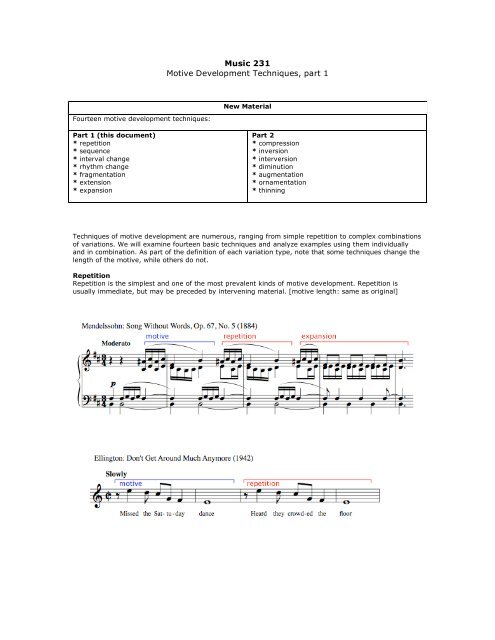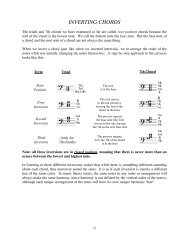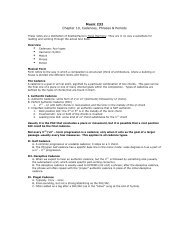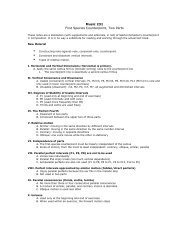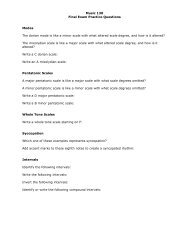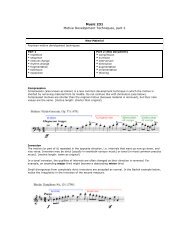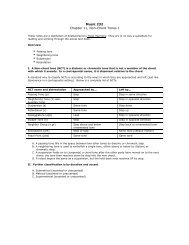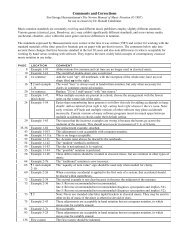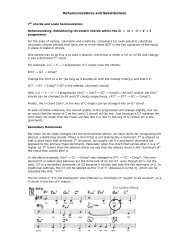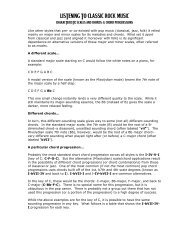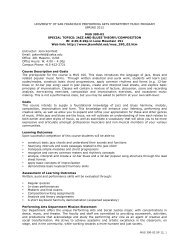Music 231 Motive Development Techniques, part 1 - Jkornfeld.net
Music 231 Motive Development Techniques, part 1 - Jkornfeld.net
Music 231 Motive Development Techniques, part 1 - Jkornfeld.net
Create successful ePaper yourself
Turn your PDF publications into a flip-book with our unique Google optimized e-Paper software.
<strong>Music</strong> <strong>231</strong><strong>Motive</strong> <strong>Development</strong> <strong>Techniques</strong>, <strong>part</strong> 1Fourteen motive development techniques:New MaterialPart 1 (this document)* repetition* sequence* interval change* rhythm change* fragmentation* extension* expansionPart 2* compression* inversion* interversion* diminution* augmentation* ornamentation* thinning<strong>Techniques</strong> of motive development are numerous, ranging from simple repetition to complex combinationsof variations. We will examine fourteen basic techniques and analyze examples using them individuallyand in combination. As <strong>part</strong> of the definition of each variation type, note that some techniques change thelength of the motive, while others do not.RepetitionRepetition is the simplest and one of the most prevalent kinds of motive development. Repetition isusually immediate, but may be preceded by intervening material. [motive length: same as original]
SequenceThe motive is repeated at another pitch level. In most common-practice music, the motive is transposedtonally, i.e. without chromatic alterations. The result is that intervals may change quality (but notnumber). [motive length: same as original]In the Beethoven example below, the motive's opening major third becomes a minor third in thesequences that follow. Similarly, the interval between the third and fourth notes is a major second in themotive and first sequence, but a minor second in the final sequence. The example from Scheherazade is aliteral sequence; every tone has been transposed a major second (sometimes written as a diminishedthird) higher.
Interval changeThe most common interval change occurs at the end of a otherwise literal motive repetition. But they canalso occur anywhere in a motive and include one or several intervals. [motive length: same as original]
playRhythm changeRhythm changes add a subtle change to a motive. [motive length: same as original]In the Mozart example below, the added sixteenth notes give the third bar an extra push forward. Therhythm alteration in the Stravinsky moves second beat accent between D and E. Copland uses rhythmicchanges to add more motion to each consecutive measure.FragmentationOne germ of a motive may be repeated and varied separately from the rest of the motive. [motive length:shorter than original]This is central to the music Haydn and Beethoven, and is found in the music of every common-practicecomposer.
Fragmentation, example 1Fragmentation, example 2
Extension and ExpansionExtension and expansion both involve lengthening the motive. If new material (or fragments, etc.) comesbefore the final note, it is referred to as an expansion. If new material begins with the final note, delayingthe expected cadence, it is referred to as an extension. [motive length: longer than original]
Other examples:1 Expansion in: Mendelssohn, Song Without Words, Op. 67, No. 5, above2 Extension in: Beethoven, Symphony No. 4, Trio from the Minuet, above3 Extension in: Mozart, Piano Sonata, K332, aboveThe E-flat clari<strong>net</strong> solo in the first movement of John Adam's Chamber Symphony provides a <strong>part</strong>icularlyinteresting use of motive extensions. Note the length in beats of each extended motive.
Extensions in John Adams CHAMBER SYMPHONYPlease note: the information on this page has been supplied by Dr. Ronald Caltabiano


